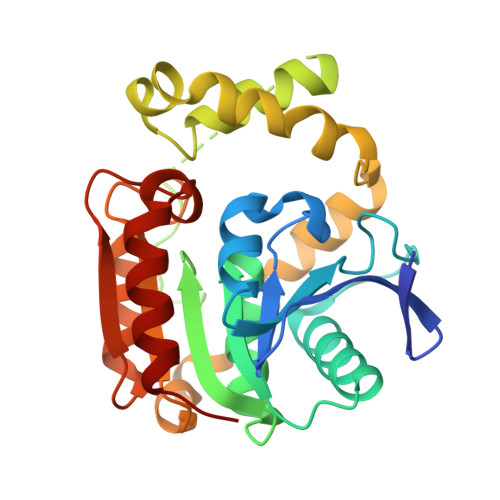Monomeric Esterase: Insights into Cooperative Behavior, Hysteresis/Allokairy.
Vinces, T.C., de Souza, A.S., Carvalho, C.F., Visnardi, A.B., Teixeira, R.D., Llontop, E.E., Bismara, B.A.P., Vicente, E.J., Pereira, J.O., de Souza, R.F., Yonamine, M., Marana, S.R., Farah, C.S., Guzzo, C.R.(2024) Biochemistry 63: 1178-1193
- PubMed: 38669355
- DOI: https://doi.org/10.1021/acs.biochem.3c00668
- Primary Citation of Related Structures:
8V16 - PubMed Abstract:
Herein, we present a novel esterase enzyme, Ade1, isolated from a metagenomic library of Amazonian dark earths soils, demonstrating its broad substrate promiscuity by hydrolyzing ester bonds linked to aliphatic groups. The three-dimensional structure of the enzyme was solved in the presence and absence of substrate (tributyrin), revealing its classification within the α/β-hydrolase superfamily. Despite being a monomeric enzyme, enzymatic assays reveal a cooperative behavior with a sigmoidal profile (initial velocities vs substrate concentrations). Our investigation brings to light the allokairy/hysteresis behavior of Ade1, as evidenced by a transient burst profile during the hydrolysis of substrates such as p -nitrophenyl butyrate and p -nitrophenyl octanoate. Crystal structures of Ade1, coupled with molecular dynamics simulations, unveil the existence of multiple conformational structures within a single molecular state (E̅ 1 ). Notably, substrate binding induces a loop closure that traps the substrate in the catalytic site. Upon product release, the cap domain opens simultaneously with structural changes, transitioning the enzyme to a new molecular state (E̅ 2 ). This study advances our understanding of hysteresis/allokairy mechanisms, a temporal regulation that appears more pervasive than previously acknowledged and extends its presence to metabolic enzymes. These findings also hold potential implications for addressing human diseases associated with metabolic dysregulation.
- Department of Microbiology, Institute of Biomedical Sciences, University of São Paulo, São Paulo CEP 05508-000, Brazil.
Organizational Affiliation:

















